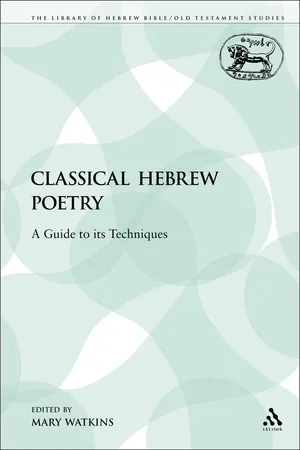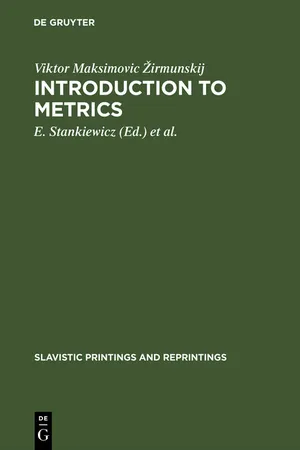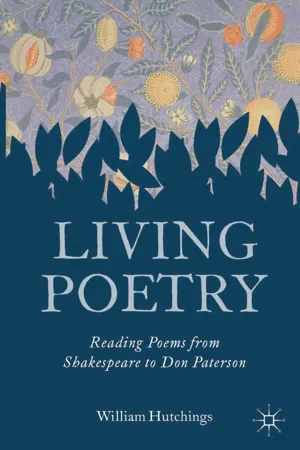Literature
Strophe
A strophe is a structural division in a poem or song, typically consisting of a series of lines with a specific meter and rhyme scheme. It is often used to mark a shift in tone, theme, or narrative within the work. In ancient Greek poetry, a strophe was also a part of a choral ode, performed by a chorus in conjunction with the antistrophe and epode.
Written by Perlego with AI-assistance
4 Key excerpts on "Strophe"
- eBook - PDF
Classical Hebrew Poetry
A Guide to its Techniques
- Wilfred G. E. Watson(Author)
- 1984(Publication Date)
- Sheffield Academic Press(Publisher)
7 STANZA AND Strophe 7.1 The Stanza Introduction One of the problems inherent in discussions of whether or not there are Strophes or stanzas in Hebrew poetry (or, for that matter, in Ugaritic and Akkadian) concerns terminology. Different scholars use the same terms to mean different things, some referring to a major subdivision in a poem as a 'Strophe', others as a 'stanza'. The result has been that these terms have become almost interchangeable, adding to the confusion. Accordingly, exact definitions are a necessary preliminary so that, at the outset, we know what we are talking about. Another source of confusion is the preconception (based on Greek classical poetry) that the structure of Strophes and stanzas has to be regular. It would seem that the poets we are considering had a greater degree of freedom in this matter; once that is conceded a great deal of misunderstanding can be removed at one go. (Ultimately, this aspect too is a question of terminology: should one refer to irregularly structured blocks of verse as Strophes and stanzas or not? If the answer is yes, then we can carry on from there.) Before setting out the appropriate definitions a few words are in order concerning recent research on the stanza. The most valuable study to date (and one of the most recent) is undoubtedly E. Haublein's The Stanza, a short, clearly written book with a useful, annotated bibliography which develops ideas first set out in Smith's work on closure. 1 The only comprehensive survey for Hebrew (Semitic) poetry remains Kraft's 1938 monograph 2 which he partially 1. Smith, Closure. 2. Kraft: 1938. See note 4. Stanza and Strophe 161 updated with a discussion of the stanza in Ugaritic. 3 There have been other, sporadic studies (see bibliography), the most significant being de Moor's pioneering paper 4 to which fuller reference will be made later. Definitions The stanza is a subunit within a poem, and a Strophe is a subunit within a stanza. - eBook - PDF
Introduction to metrics
The theory of verse
- Viktor Maksimovic Žirmunskij, E. Stankiewicz, W. N. Vickery, C. F. Brown(Authors)
- 2016(Publication Date)
- De Gruyter Mouton(Publisher)
16 BASIC CONCEPTS which yield a still longer sequence, the unit of the highest order in the given poem — the stanza. The poem has three stanzas of identical con-struction. The most important factor distinguishing this bit of poetry from a sample of prose is the orderly arrangement of syllables and stresses within the limits of the line, the period and the stanza. In addition to the fundamental alternation of stress, there exists also a secondary organizing phonetic principle. There is, for example, an arrangement, of a very free sort, of the qualitative elements of sound, a patterning of vowels and consonants (verbal orchestration). Thus, the harmonizing endings (rhymes) are repeated at corresponding places in the line; the distribution of stressed vowels in the first two lines of the first stanza is identical (vowel harmony): a — a — o, a — a — o; the third line has three identical vowels: o — o — o; note also lines one and three in the second stanza: a — i — a, a — y — a; in the third stanza, line two : a — a — a, and so on. But not only the phonetic form of the verse follows a regular pattern; there is also, against the background of corresponding phonetic alterna-tions, an artistic arrangement of syntactic and semantic elements. Each line forms a closed and complete syntactic unit, the sentence. Within the stanza neighboring lines (1-2 and 3-4) are linked by syntactic parallelism and by repetition of the initial words (anaphora). This division of the stanza into two syntactically isolated periods extends throughout the entire poem, while the chain of syntactic correspondences and the use of anaphora unite the periods both at the beginning of each stanza and at the end. This is matched by the semantic grouping: the first and second tell the story of a woman whom the poet loves; the third and fourth, which stand apart from them and contrast with them, contain a picture of nature in the form of lyrical exclamations. - Whilst the reader might want to argue that the stanza is not really a visual effect, certainly not of the kind we have discussed so far, it matters here because all stanzaic forms when ren-dered in print address themselves to the reading eye. Even people supposedly well informed about poetry (such as the authors of this book) would be hard put to give an accurate description of a poem’s stanzaic form merely through hearing the work being read aloud. A poem’s stanzaic form is most evident when it is encountered in its visual dimension. 34 Poetry Perhaps the most notable aspect of the visual organisation of poetry on the printed page is the division of many poems into groups of lines, or ‘stanzas’: She dwelt among the untrodden ways Beside the springs of Dove, A Maid whom there were none to praise And very few to love: A violet by a mossy stone Half hidden from the eye! Fair as a star, when only one Is shining in the sky. She lived unknown, and few could know When Lucy ceased to be; But she is in her grave, and oh, The difference to me! (Wordsworth) A stanza is a subdivision or section of a poem, and a poem’s stanzas generally share the same line-length, rhyme scheme and poetic metre. Pauses between stanzas are marked by a space line on the printed page. A poem divided into stanzas is thus referred to as ‘stanzaic’. The term ‘verse’ is not infrequently used for stanza, especially with reference to the lyrics of pop songs or hymns, but should perhaps be avoided, given that a verse is more properly a single line of a poem.
- eBook - PDF
Living Poetry
Reading Poems from Shakespeare to Don Paterson
- William Hutchings(Author)
- 2012(Publication Date)
- Bloomsbury Academic(Publisher)
Part One Elements of Poetry 2 Form and Technique Poetry is not the thing said but a way of saying it. (A. E. Housman) 1 The materials of poetry are words. Poems are created step by step, by building words into structures, beginning with the phrases and clauses that make up the lines, stanzas and other formal sections. A poet – the word derives from the Greek meaning ‘maker’ – con-structs the whole from these parts. It is with this etymology that George Puttenham began his highly significant and influential tract in the development of English rhetoric and poetics, The Arte of English Poesie , published in 1589: ‘A poet is as much to say as a maker.’ 2 Poets’ techniques, the skills they employ in the service of their craft, lie in selecting their material and then shaping it into an expressive work of art. In this chapter we shall look at examples of poets’ handling of these elements, beginning with individual words and building gradually into formal sections of a poem. 2.1 The word A word is the smallest unit of meaning. Syllables and even individ-ual letters can have a purpose within the aural structure of a longer section of writing, but selection of words is the writer’s first step towards expression of thought or feeling. It is, indeed, often the case that we can observe the essence of a poet in her or his range of 13 14 Living Poetry vocabulary. We here look at three examples. Andrew Marvell locates his meaning in the choice and definition of individual words: he is a poet of the concise and the precise. Shakespeare’s sonnets use lan-guage in multiple and shifting ways. His words slide around to create complex and sometimes uncertain textures of meaning. Alexander Pope uses language with Marvell’s precision, but the significance of his key words is often fully revealed only by observing their position within the structure of the whole poem.
Index pages curate the most relevant extracts from our library of academic textbooks. They’ve been created using an in-house natural language model (NLM), each adding context and meaning to key research topics.



